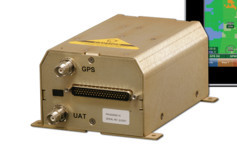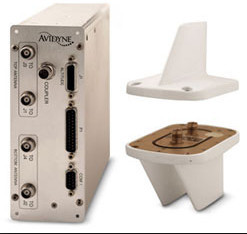Isn’t this just ADS-B (which almost no GA radiates, especially not the sort of GA you might bump into) and not an active TAS system?

“The Lynx NGT-9000+ is equipped with the L-3 NextGen Active Traffic enablement " and has the same chipset as the turboprop and bizjet Skywatch 899HP system. So you will see anyone with mode A, C or S.
I am not sure it provides azimuth (bearing) information.
There are just two RF connectors on their box

and there is no way to get azimuth with just two RF cables.
The active TAS/TCAS boxes use four. One antenna resolves left/right and the other antenna resolves forwarda/backwards e.g.

I went around this block when planning my TAS605 installation. I found some US products which “did” this with just 1 or 2 antennae. I could not see how this could work and sure enough reading some reviews I don’t think they do.
Peter wrote:
Isn’t this just ADS-B (which almost no GA radiates, especially not the sort of GA you might bump into) and not an active TAS system?
Yes, but remember there are different ADS-B systems. Air to Air (as used in Europe) or Ground to Air, as used in USA. Then they can “upload” traffic as received by ground station / ATC to the aircraft. There system can also be used combined with an older active TAS system (requiring multiple antenna’s)
I know you don’t like ADS-B, but it is the system of the future, and more and more air are radiating ADS-B out.
The unit on your photo has UAT connector (ADS-B on a different frequency then transponder frequency, as used in the USA), and GPS as it has an internal WAAS receiver for certified / compliant ADS-B out.
@peter you are right, the NGT2500 doesn’t specify azimuth information. If you check closely, I did not suggest the 2500, but the 9000+ (entirely different animal), and it was for a very specific reason. If you were to check, both the NY156 and 164 are directional antennas with two TNC and one BNC connectors, and the 9000+ comes with three extra RF cable assemblies over the 9000 box… Just saying.

I just clicked on that link you posted, Shorrick, so thanks for the info. The more options the better.
FWIW, my Avidyne TAS605 performs sub-optimally on certain bearings e.g. head-on it is only 1-2nm. This is enough for GA work. Sideways it is nearer to 5-10nm. They claim 15nm but this is almost never seen except against jets. Maybe the installer did yet another bodge…
I know you don’t like ADS-B, but it is the system of the future
Not at all, Jesse. I just like to always point out both sides of an argument. Some people (not saying this is you) point out the positives and don’t mention what doesn’t work, because that results in a more “aspirational” writing, and makes them appear in good light because it looks more like they have their life totally under control and get up to lots of “fun” things. Unfortunately that can lead other people to go up a useless road. I hear an awful lot in the background… So my writing looks more “glass half empty” and I apologise for that 
With regard to ADS-B I think this is a great technology. Active TCAS is a poor solution to traffic avoidance, not least due to the poor accuracy of the azimuth and the reliance on peoples’ transponders having accurate altitude. But if you are going to spend €XXXX or €XXXXX on extra kit, I would not put ADS-B on the list right now. In the TAS context, “we” still struggle with so many pilots not even switching on Mode C (due to ignorance, for “privacy”, to make it harder to get done for a CAS bust, etc). These same people won’t have ADS-B working either (in the highly unlikely case they even have it) because it is all linked together. The tiny number of GA ADS-B emitters is a different demographic and is not going to be found going around the Isle of Wight on a Sunday afternoon, 1500ft, non-radio. Or flying straight through the platform of your local IAP, also non-radio 
Peter wrote:
With regard to ADS-B I think this is a great technology
I would transponder usage is very different in other countries. It’s really rare to see a Dutch aircraft without an transponder or not using it. Sure enough there are examples. It seems that this is completely different in the UK based on your posting. There are quire some with ADS-B out, and there are more and more people seeing the benefits. The major drawback of this air to air ADS-B as used in Europe, is that to be a reliable systems it should used by all. Again I see quite some Dutch and German aircraft which radiate ADS-B out.
Peter wrote:
Active TCAS is a poor solution to traffic avoidance, not least due to the poor accuracy of the azimuth and the reliance on peoples’ transponders having accurate altitude.
Sure, this is why ADS-B could be so much better. Currently active TCAS (possibly with ADS-B in) is the best product on the market, as you can detect the most, and detect in a usefull way, with a reasonable azimuth. Azimuth errors of over lets say 30 degrees are often caused by antenna issues or poor installation.
The dependency of the accurate altitude will always stay, which is the reason that this is frequently tested and requires repair before further flight if incorrect.
I dug up this old thread ‘cause I have a client that is complaining that his TAS 600 has started to “shadow”, that is report itself as a target , although it’s been trouble-free for some years now..
Any ideas what might cause this all of a sudden ?
If a TAS is seeing its host aircraft as a target, then the suppression system isn’t working so the onboard transponder is responding to the TAS interrogations. This could be a transponder fault, suppression wiring between the transponder and TAS, or the TAS antenna coupler/co-ax. So initial checks are probably the suppression bus and coupler wiring and then substitute the transponder.
A big thanks @Wigglyamp for that !
Will investigate and revert .